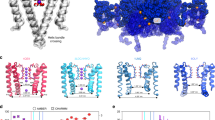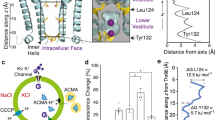Abstract
Ion channels form transmembrane water-filled pores that allow ions to cross membranes in a rapid and selective fashion. The amino acid residues that line these pores have been sought to reveal the mechanisms of ion conduction and selectivity1,2,3,4,5,6,7. The pore (P) loop8 is a stretch of residues that influences single-channel-current amplitude, selectivity among ions and open-channel blockade2,3,5 and is conserved in potassium-channel subunits previously recognized to contribute to pore formation5,9. To date, potassium-channel pores have been shown to form by symmetrical alignment of four P loops around a central conduction pathway10,11,12. Here we show that the selectivity-determining pore region of the voltage-gated potassium channel of human heart through which the IKs current passes includes the transmembrane segment of the non-P-loop protein minK. Two adjacent residues in this segment of minK are exposed in the pore on either side of a short barrier that restricts the movement of sodium, cadmium and zinc ions across the membrane. Thus, potassium-selective pores are not restricted to P loops or a strict P-loop geometry.
This is a preview of subscription content, access via your institution
Access options
Subscribe to this journal
Receive 51 print issues and online access
$199.00 per year
only $3.90 per issue
Buy this article
- Purchase on Springer Link
- Instant access to full article PDF
Prices may be subject to local taxes which are calculated during checkout




Similar content being viewed by others
References
MacKinnon, R. & Miller, C. Mutant potassium channels with altered binding of charybdotoxin, a pore-blocking peptide inhibitor. Science 245, 1382–1385 (1989).
Yellen, G., Jurman, M. E., Abramson, T. & MacKinnon, R. Mutations affecting internal TEA blockade identify the probably pore-forming region of a K+ channel. Science 251, 939–942 (1991).
Hartmann, H. A. et al. Exchange of conduction pathways between two related K+ channels. Science 251, 942–944 (1991).
Goldstein, S. A., Pheasant, D. J. & Miller, C. The charybdotoxin receptor of a Shaker K+ channel: peptide and channel residues mediating molecular recognition. Neuron 12, 1377–1388 (1994).
Heginbotham, L., Lu, Z., Abramson, T. & MacKinnon, R. Mutations in the K+ channel signature sequence. Biophys. J. 66, 1061–1067 (1994).
Lu, Q. & Miller, C. Silver as a probe of pore-forming residues in a potassium channel. Science 268, 304–307 (1995).
Ranganathan, R., Lewis, J. H. & MacKinnon, R. Spatial localization of the K+ channel selectivity filter by mutant cycle-based structure analysis. Neuron 16, 131–139 (1996).
MacKinnon, R. Pore loops: an emerging theme in ion channel structure. Neuron 14, 889–892 (1995).
Goldstein, S. A. N., Wang, K. W., Ilan, N. & Pausch, M. Sequence and function of the two P domain potassium channels: implications of an emerging superfamily. J. Mol. Med. 76, 13–20 (1998).
MacKinnon, R. Determination of the subunit stoichiometry of a voltage-activated potassium channel. Nature 350, 232–235 (1991).
Shen, K. Z. et al. Tetraethylammonium block of Slowpoke calcium-activated potassium channels expressed in Xenopus oocytes: evidence for tetrameric channel formation. Pflugers Arch. 426, 440–445 (1994).
Glowatzki, E. et al. Subunit-dependent assembly of inward-rectifier K+ channels. Proc. R. Soc. Lond. B 261, 251–261 (1995).
Sanguinetti, M. C. 7 Jurkiewicz, N. K. Two components of cardiac delayed rectifier K+ current. Differential sensitivity to block by class III antiarrhythmic agents. J. Gen. Physiol. 96, 195–215 (1990).
Sanguinetti, M. C. et al. Coassembly of K(V)Lqt1 and Mink (Isk) proteins to form cardiac I-Ks potassium channel. Nature 384, 80–83 (1996).
Barhanin, J. et al. K(V)LQT1 and 1sK (minK) proteins associate to form the I(Ks) cardiac potassium current. Nature 384, 78–80 (1996).
McDonald, T. V. et al. AminK–HERG complex regulates the cardiac potassium current I Kr. Nature 388, 289–292 (1997).
Goldstein, S. A. & Miller, C. Site-specific mutations in a minimal voltage-dependent K+ channel alter ion selectivity and open-channel block. Neuron 7, 403–408 (1991).
Attali, B. et al. The protein IsK is a dual activator of K+ and Cl− channels. Nature 365, 850–852 (1993).
Wang, K. W. & Goldstein, S. A. N. Subunit composition of minK potassium channels. Neuron 14, 1303–1309 (1995).
Wang, K.-W., Tai, K.-K. & Goldstein, S. A. N. MinK residues line a potassium channel pore. Neuron 16, 571–577 (1996).
Tai, K.-K., Wang, K.-W. & Goldstein, S. A. N. MinK potassium channels are heteromultimeric complexes. J. Biol. Chem. 272, 1654–1658 (1997).
Romey, G. et al. Molecular mechanism and functional significance of the minK control of the KvLQT1 channel activity. J. Biol. Chem. 272, 16713–16716 (1997).
Yellen, G., Sodickson, D., Chen, T. Y. & Jurman, M. E. An engineered cysteine in the external mouth of a K+ channel allows inactivation to be modulated by metal binding. Biophys. J. 66, 1068–1075 (1994).
Blumenthal, E. M. & Kaczmarek, L. K. The minK potassium channel exists in functional and nonfunctional forms when expressed in the plasma membrane of Xenopus oocytes. J. Neurosci. 14, 3097–3105 (1994).
Armstrong, C. M. Inactivation of the potassium conductance and related phenomena caused by quaternary ammonium ion injection in squid axons. J. Gen. Physiol. 54, 553–575 (1969).
Latorre, R. & Miller, C. Conduction and selectivity in potassium channels. J. Membr. Biol. 71, 11–30 (1983).
Yang, N., George, A. L. J & Horn, R. Molecular basis of charge movement in voltage-gated sodium channels. Neuron 16, 113–122 (1996).
Goldstein, S. A. N. Astructural vignette common to voltage sensors and conduction pores: canaliculi. Neuron 16, 717–722 (1996).
Pascual, J. M., Shieh, C. C., Kirsch, G. E. & Brown, A. M. K+ pore structure revealed by reporter cysteines at inner and outer surfaces. Neuron 14, 1055–1063 (1995).
Dwyer, T. M., Adams, D. J. & Hille, B. The permeabiity of the endplate channel to organic cations in frog muscle. J. Gen. Physiol. 75, 469–492 (1980).
Acknowledgements
We thank G. Abbott, B. Fakler, P. Ruppersberg and K. W. Wang for helpful discussions. The work was supported by a grant from the NIH-NIGMS to S.A.N.G. We also thank the late Dorothy W. Goldstein, to whom this paper is dedicated.
Author information
Authors and Affiliations
Corresponding author
Rights and permissions
About this article
Cite this article
Tai, KK., Goldstein, S. The conduction pore of a cardiac potassium channel. Nature 391, 605–608 (1998). https://doi.org/10.1038/35416
Received:
Accepted:
Issue Date:
DOI: https://doi.org/10.1038/35416
This article is cited by
-
A general mechanism of KCNE1 modulation of KCNQ1 channels involving non-canonical VSD-PD coupling
Communications Biology (2021)
-
Opening of an alternative ion permeation pathway in a nociceptor TRP channel
Nature Chemical Biology (2014)
-
Molecular mechanism of the assembly of an acid-sensing receptor ion channel complex
Nature Communications (2012)
-
Gating-Related Molecular Motions in the Extracellular Domain of the IKs Channel: Implications for IKs Channelopathy
The Journal of Membrane Biology (2011)
-
Probing the Interaction Between KCNE2 and KCNQ1 in Their Transmembrane Regions
Journal of Membrane Biology (2007)
Comments
By submitting a comment you agree to abide by our Terms and Community Guidelines. If you find something abusive or that does not comply with our terms or guidelines please flag it as inappropriate.



